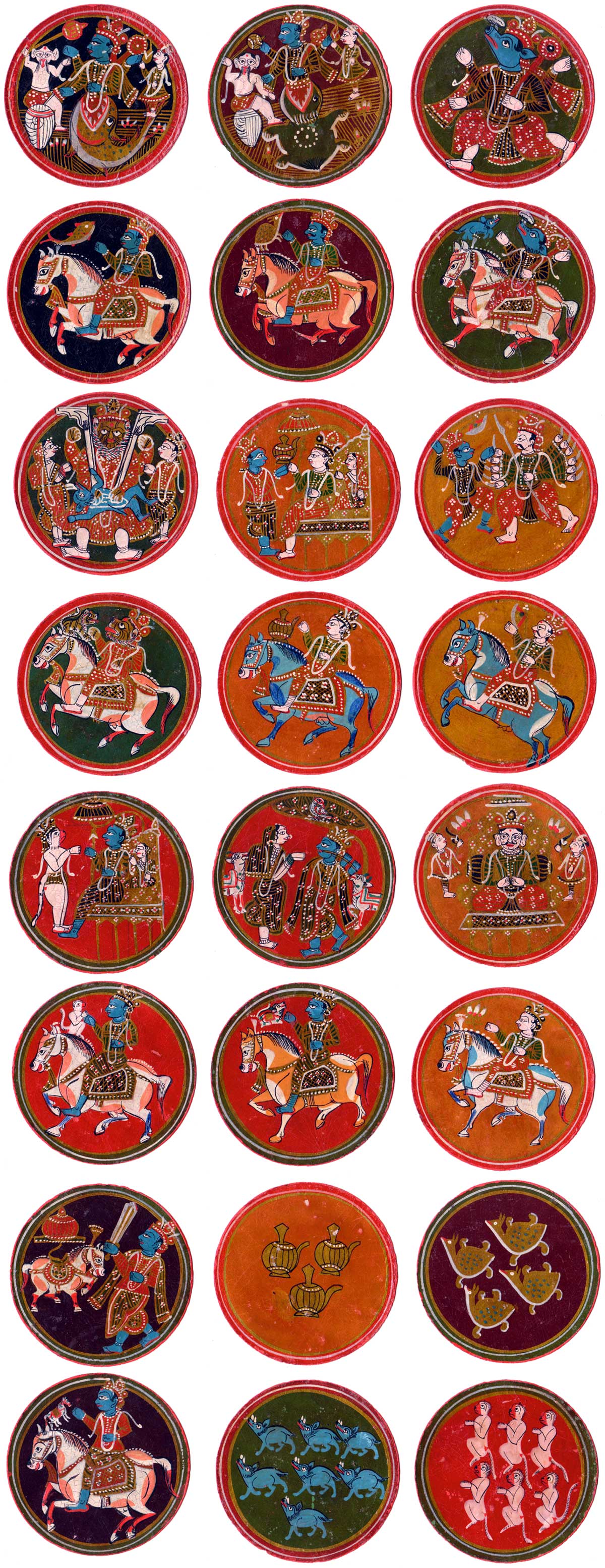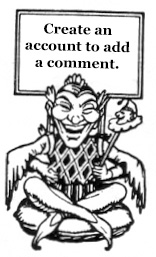Indian Ganjifa Playing Cards
‘Ganjifa’ playing cards made in Sheopor in the North of Madhya Pradesh province in Central India. The Ganjifa game probably developed from 13th century games played by Mamluk immigrants from China.
These beautiful playing cards were made in Sheopor in the North of Madhya Pradesh province in Central India. The Ganjifa game probably developed from 13th century games played by Mamluk immigrants from China¹. Fragments of the Mamluk version of Ganjifa have been found in Egypt. They are made in the same traditional way that has been handed down from father to son for many generations.
The basic body of the cards is a stiffened cloth or paper made from rags or even just from old cotton rags. The cards are all painted by hand, the apprentice getting the boring job of painting the plain backs and the base background over which the pictures are painted by the experienced artists.
In Central India where these cards came from they use a 10 suited pack and the game is mostly a trick taking game with some extra rules and complications. You need a good memory to play Ganjifa with 120 cards to cope with. Other parts of India use 8 suited packs or 12 suited packs to play.
The 10 suited packs represent the 10 incarnations of the God Vishnu and there are 2 Court cards and 10 number cards in each suit. The images show the two court cards from each suit one above the other - the top card of each suit is the major card and the horseman card beneath is the next in value. At the end are 4 examples of some of the numbered cards. The suit signs are as follows:
Suit 1 - Matsya, the first incarnation of Vishnu. The card shows him emerging from the mouth of a fish. The suit sign is a fish.
Suit 2 – Kurma, the second incarnation. The card shows him emerging from the mouth of a turtle, the suit sign is a turtle.
Suit 3 – Varaha, the third incarnation. The card shows Vishnu as a boar. The suit sign is a boar.
Suit 4 – Narasimha, the fourth incarnation. Vishnu is a lion/man disembowelling a demon called Hiranya-Kashipu. The suit sign is a lion or a Chakra quoit weapon.
Suit 5 – Vamana, the fifth incarnation. As a small Brahmin Vishnu approaches King Bali with a gift of land. The suit sign is a water vessel or an umbrella.
Suit 6 – Parashurama, the sixth incarnation. Vishnu is fighting the 1000 armed Kartavirya. The suit sign is an axe.
Suit 7 – Ramachandra, the seventh incarnation. Vishnu defeats the Demon King Ravana with an axe and his monkey allies. The suit sign is an Axe or monkeys.
Suit 8 – Krishna, the eighth incarnation. This is Vishnu’s supreme incarnation and he is shown playing a flute. The suit sign is a cow or a Chakra quiot weapon.
Suit 9 – Buddha, the ninth incarnation. This shows Vishnu as Buddha seated on a throne. The suit sign is a lotus.
Suit 10 – Kalkin, the tenth incarnation. Vishnu is now an avenger on a white horse. The suit sign is a horse or a sword.
These Ganjifa packs have been made to the same designs in each area they are made and this makes them almost impossible to date. Generally the older they are the better they are, but not always. The pack is also made in different qualities depending on the price you are prepared to pay, and most of the best quality are made to order for a particular client. These cards illustrated are probably mid range quality as the work is fairly detailed and easily recognised. Some packs, however, seem to have been done at a very fast pace with little concern for artistic merit. The very best can be made with every number card and even the backs decorated to the highest standard.
The makers, who are generally family concerns, also produce handmade versions of the pack that we are more familiar with, but often with Indian characters for court cards (see example below). These can be very attractive and, usually, all the packs of cards made both Indian and others are supplied in a beautifully decorated wooden box.

Above: hand-painted ‘Ganjifa’ playing cards made in Sheopor in the North of Madhya Pradesh province in Central India.

REFERENCES
1) Leyden, Rudolf van: Ganjifa, the playing cards of India, exhibition catalogue, V&A Museum, London, 1982. Van Leyden believes that Chinese money cards were in India before 1300. Fragments found in Egypt were dated at around 1300. It is known that there were Chinese living in Iran and printing paper money for them.

By Rex Pitts (1940-2021)
Member since January 30, 2009
Rex's main interest was in card games, because, he said, they were cheap and easy to get hold of in his early days of collecting. He is well known for his extensive knowledge of Pepys games and his book is on the bookshelves of many.
His other interest was non-standard playing cards. He also had collections of sheet music, music CDs, models of London buses, London Transport timetables and maps and other objects that intrigued him.
Rex had a chequered career at school. He was expelled twice, on one occasion for smoking! Despite this he trained as a radio engineer and worked for the BBC in the World Service.
Later he moved into sales and worked for a firm that made all kinds of packaging, a job he enjoyed until his retirement. He became an expert on boxes and would always investigate those that held his cards. He could always recognize a box made for Pepys, which were the same as those of Alf Cooke’s Universal Playing Card Company, who printed the card games. This interest changed into an ability to make and mend boxes, which he did with great dexterity. He loved this kind of handicraft work.
His dexterity of hand and eye soon led to his making card games of his own design. He spent hours and hours carefully cutting them out and colouring them by hand.
Leave a Reply
Your Name
Just nowRelated Articles

Motherpeace Round Tarot
An original and imaginative feminist tarot based on Goddess energy.

Ganjifa - Playing Cards from India
Indian playing cards, known as Ganjifa, feature intricate designs with twelve suits and are traditio...

Introduction to Collecting Themes
Playing cards can be broadly categorised into standard and non-standard designs, with collectors app...

Eves Playing Cards
A pack of cards with colour photos of Indian film stars from the era

Asha Industries’ Castilian pattern
Colourful Spanish (Castilian) pattern cards made by Asha Industries in India for Mexico.

Les “Œufs de Cartes” de Krasno
Egg-shaped cards created by Rodolfo Krasno employing photographic images by Michel Leclerc.

Kings of India playing cards
Kings of India playing cards depicting the four greatest dynasties of India.

Tarot of the Thousand and One Nights (1001 Nights Tarot)
This tarot deck captures the idealised Eastern world's magic from the eighteenth and nineteenth cent...

ORIENT The Queen of Cards
A unique Art creation of Subho Tagore

Handmade Ganjifa Birds Playing Cards
This set of Ganjifa cards is a beautiful example of traditional cards from India.

Easter Playing Cards
Egg-shaped cards with rabbit designs in soft, pastel colours for Easter.

Euro Playing Cards
New euro banknotes and coins from several countries on circular cards.

The British Royal visit to India playing cards
printed in Spain for British India in 1911.

Wüst Oval Patience Playing Cards No.240
A review of all three known versions

Popular Fine Art Litho Works
A standard English pack and one adapted for magic tricks by Popular Fine Art Litho Works Ltd., Bomba...

Swadeshi Playing Cards
Named after the first National movement in India
Trending Articles
Popular articles from the past 28 days



 Your comment here. Your comment here. Your comment here. Your comment here. Your comment here. Your comment here. Your comment here. Your comment here. Your comment here. Your comment here. Your comment here. Your comment here. Your comment here. Your comment here. Your comment here. Your comment here. Your comment here. Your comment here. Your comment here. Your comment here. Your comment here. Your comment here. Your comment here. Your comment here. Your comment here. Your comment here. Your comment here. Your comment here. Your comment here. Your comment here. Your comment here. Your comment here.
Your comment here. Your comment here. Your comment here. Your comment here. Your comment here. Your comment here. Your comment here. Your comment here. Your comment here. Your comment here. Your comment here. Your comment here. Your comment here. Your comment here. Your comment here. Your comment here. Your comment here. Your comment here. Your comment here. Your comment here. Your comment here. Your comment here. Your comment here. Your comment here. Your comment here. Your comment here. Your comment here. Your comment here. Your comment here. Your comment here. Your comment here. Your comment here.